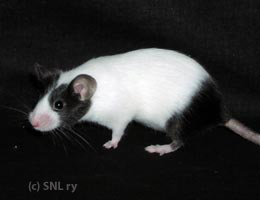Varieties
Marked
Dutch (*/du)
The genetic make-up of this variety is controvesial.
"Eye colour to be as in standardized variety. In Dutch Marked the face or cheek markings should be evenly balanced, a patch covering each side of the face, extending below the eye but not including the whiskers, and not joining between the ears at the narrowest part of the blaze. The cheek markings should not run underneath the jaw. The saddle should come well up from the tail to the middle of the body and be clean cut, top and under. Tail stop to be approximately halfway along the tail. The stops on the hind feet should come halfway between the tips of the toes and the hock. Colour of markings should be carried out in the ears. The coloured markings may be any standard colour."
Breeding information below the pictures.

|
SH Black Dutch Good cheaks, the saddle should extend higher on the back. |
Note: This article is old and waiting to be rewritten.
Quick Look
Genetic make-up of dutch mice is still rather unclear. I have read several accounts from British fanciers explaining that dutch breeds true and that you get clearly dutch mice again in second generation after a dutch x self mating. This runs contrary to the common theory of dutch being yet another recessive white spotting (s/s) variety. Another thing running contrary to this theory, is that s/s has been widely studied by geneticists, but there's a definite lack of descriptions on mice resembling dutch. Furthermore, there doesn't seem to be dutch mice popping up from s/s -spotted litters...
With rabbits, another species with similar markings, the pattern is caused by a specific gene: recessive du.
Breeding dutch mice successfully requires well planned inbreeding in order to fix good points and to breed out faults. Line breeding tends to be most common form, together with cousin to cousin matings. Dutch mice are the smallest of all fancy mice, but they shouldn't lack in fitness or stamina. The top colour is often lacking in the dutch but the colour should not be overlooked either. Most common colors are black, blue, chocolate, agouti and cinnamon. Dutch isn't generally a good mother due to the small size and low milk yield, so breeders usually use PEW does as foster mothers.
